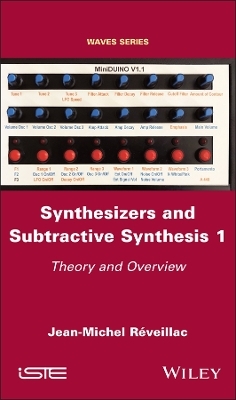
Synthesizers and Subtractive Synthesis 1
ISTE Ltd and John Wiley & Sons Inc (Verlag)
978-1-78630-924-2 (ISBN)
It is based on a simple principle, but its operation remains complex, involving many parameters. It can be enriched by a variety of effects that give the sound its authenticity. It does not just imitate musical instruments, but can also transcribe noises present in natural soundscapes, or generate entirely synthetic sounds.
Synthesizers and Subtractive Synthesis 1 presents the theoretical basis of a sound phenomenon, the different types of synthesis, the components that are required and present in synthesizers, the working environment specific to the study of subtractive synthesis, and the hardware and software available.
After reading the various chapters of this book, readers will have a clear vision of the tools and actions required to grasp the world of subtractive sound.
Jean-Michel Réveillac has been a specialist in sound processing and synthesis for 35 years. He is an associate lecturer at the University of Burgundy, France, a consultant to media companies, and runs a sound restoration, mixing and transcoding studio.
Preface xi
Introduction xv
Chapter 1 Sound Synthesis 1
1.1 The art of creating sound 1
1.2 Some reminders 2
1.2.1 Sound: a bit of theory 2
1.2.2 Intensity 4
1.2.3 Pitch of a sound 7
1.2.4 Timbre 9
1.2.5 The ear 10
1.3 Sound typology 21
1.3.1 Sounds and periods 22
1.3.2 Simple and complex sounds 23
1.4 Spectral analysis 25
1.4.1 The sound spectrum 25
1.4.2 Sonogram and spectrogram 27
1.5 Waveforms 28
1.5.1 Sine wave 29
1.5.2 Square wave 29
1.5.3 Rectangular wave 31
1.5.4 Pulse wave 35
1.5.5 Triangular wave 35
1.5.6 Sawtooth wave 37
1.6 Timbre 39
1.6.1 Transient phenomena 40
1.6.2 Range 41
1.6.3 Mass of musical objects 42
1.6.4 Classification of sounds 43
1.7 Sound propagation 44
1.7.1 Dispersion 44
1.7.2 Interference 45
1.7.3 Diffraction 48
1.7.4 Reflection 50
1.7.5 Reverberation (reverb) 51
1.7.6 Absorption 54
1.7.7 Refraction 55
1.7.8 Doppler effect 55
1.7.9 Phase and beat 57
1.8 Noise 58
1.8.1 White noise 59
1.8.2 Pink noise 59
1.8.3 Red noise 60
1.8.4 Blue noise 61
1.8.5 Purple noise 62
1.8.6 Gray noise 62
1.8.7 Other noise 63
1.9 History of sound synthesis 63
1.10 Conclusion 70
Chapter 2 The Different Types of Synthesis 71
2.1 Subtractive synthesis 71
2.2 Additive synthesis 74
2.3 FM synthesis 78
2.4 Digital synthesis, sampling and wavetables 88
2.5 Physical modeling synthesis 90
2.6 Granular synthesis 93
2.7 Amplitude modulation synthesis 96
2.8 Phase distortion synthesis 98
2.9 Other types of sound synthesis 99
Chapter 3 Components, Processing Techniques and Tools 101
3.1 Oscillators 101
3.1.1 Voltage-controlled oscillators 102
3.1.2 Digitally controlled oscillators 103
3.1.3 Digital oscillators 104
3.1.4 Low-frequency oscillators 104
3.2 Filters 105
3.2.1 Low-pass filters 106
3.2.2 High-pass filters 108
3.2.3 Band-pass filters 108
3.2.4 Band-stop filters 110
3.2.5 Resonance 110
3.2.6 Other filters 111
3.3 The envelope generator 112
3.3.1 Attack 114
3.3.2 Decay 114
3.3.3 Sustain 115
3.3.4 Release 115
3.3.5 Other parameters 116
3.4 Amplifiers 117
3.5 Sample and hold 118
3.6 Ring modulator 120
3.7 Waveshaping 122
3.8 Special effects 124
3.8.1 Pitchbend 124
3.8.2 Glide 125
3.8.3 Keyboard tracking 126
3.8.4 Reverb and delay 127
3.8.5 Phaser, chorus and flanger 128
3.9 From monody to polyphony 129
3.10 Controllers 132
3.10.1 Modwheel 132
3.10.2 Breath controller 133
3.10.3 Expression switch and pedal 133
3.10.4 Keytar 134
3.10.5 Other controllers 135
Chapter 4 Work Environment 137
4.1 Materials 137
4.1.1 ARP 2600 138
4.1.2 The Minimoog 147
4.1.3 The Behringer Neutron 152
4.1.4 The Novation Bass Station II 156
4.1.5 The Arturia MatrixBrute 160
4.2 Software 167
4.2.1 Native Instruments Reaktor 167
4.2.2 VCV Rack 2 168
4.2.3 Cycling ‘74 Max/MSP 170
4.2.4 Pure Data 171
4.3 Conclusion 173
Chapter 5 CV/Gate and MIDI 175
5.1 CV/Gate 175
5.1.1 Overview 175
5.1.2 Operation 176
5.1.3 Note definition 176
5.1.4 Operation of the gate (or trigger) 180
5.2 Musical Instrument Digital Interface 180
5.2.1 MIDI version 1.0 180
5.2.2 MIDI Version 2.0 181
5.2.3 Principle 183
5.2.4 The hardware 184
5.2.5 The software 187
5.2.6 MIDI Control Change 191
5.2.7 Examples of MIDI transmission 194
5.2.8 MIDI implementation chart 198
5.2.9 General MIDI standard 199
5.2.10 The General MIDI 2 standard 200
5.2.11 The GS format 201
5.2.12 The XG format 202
5.2.13 MIDI file structure 203
5.2.14 An example of a MIDI file 211
5.3 MIDI CV/Gate converters 213
Conclusion 215
Appendix 1 General MIDI 1 and 2 Instruments 217
Appendix 2 MIDI Box, Merger and Patcher 235
Glossary 237
References 245
Index 255
| Erscheinungsdatum | 15.03.2024 |
|---|---|
| Verlagsort | London |
| Sprache | englisch |
| Gewicht | 680 g |
| Themenwelt | Naturwissenschaften ► Chemie |
| Technik | |
| ISBN-10 | 1-78630-924-6 / 1786309246 |
| ISBN-13 | 978-1-78630-924-2 / 9781786309242 |
| Zustand | Neuware |
| Informationen gemäß Produktsicherheitsverordnung (GPSR) | |
| Haben Sie eine Frage zum Produkt? |
aus dem Bereich


